Comprehensive Report on Financial Management, Auditing, and Taxation
VerifiedAdded on 2023/06/17
|8
|1974
|244
Report
AI Summary
This report provides a comprehensive overview of financial management, auditing, and taxation within a business context. It identifies and discusses financial probity requirements, fraudulent behaviors related to company finances, and the purpose of audit reports. The report explains the principles of cash and accrual accounting, outlines taxation and superannuation obligations, and identifies the act related to financial reporting and auditing along with its requirements. It further elaborates on the requirements for registered foreign companies, current company tax rates, the process of reporting GST to the Australian Tax Office, penalties for not providing an ABN, and GST registration requirements for non-profit organizations. Finally, it explains the difference between Pay as you go withholding obligations for employees and contractors, providing a holistic view of financial compliance and management.

Manage Finance
Paraphrase This Document
Need a fresh take? Get an instant paraphrase of this document with our AI Paraphraser
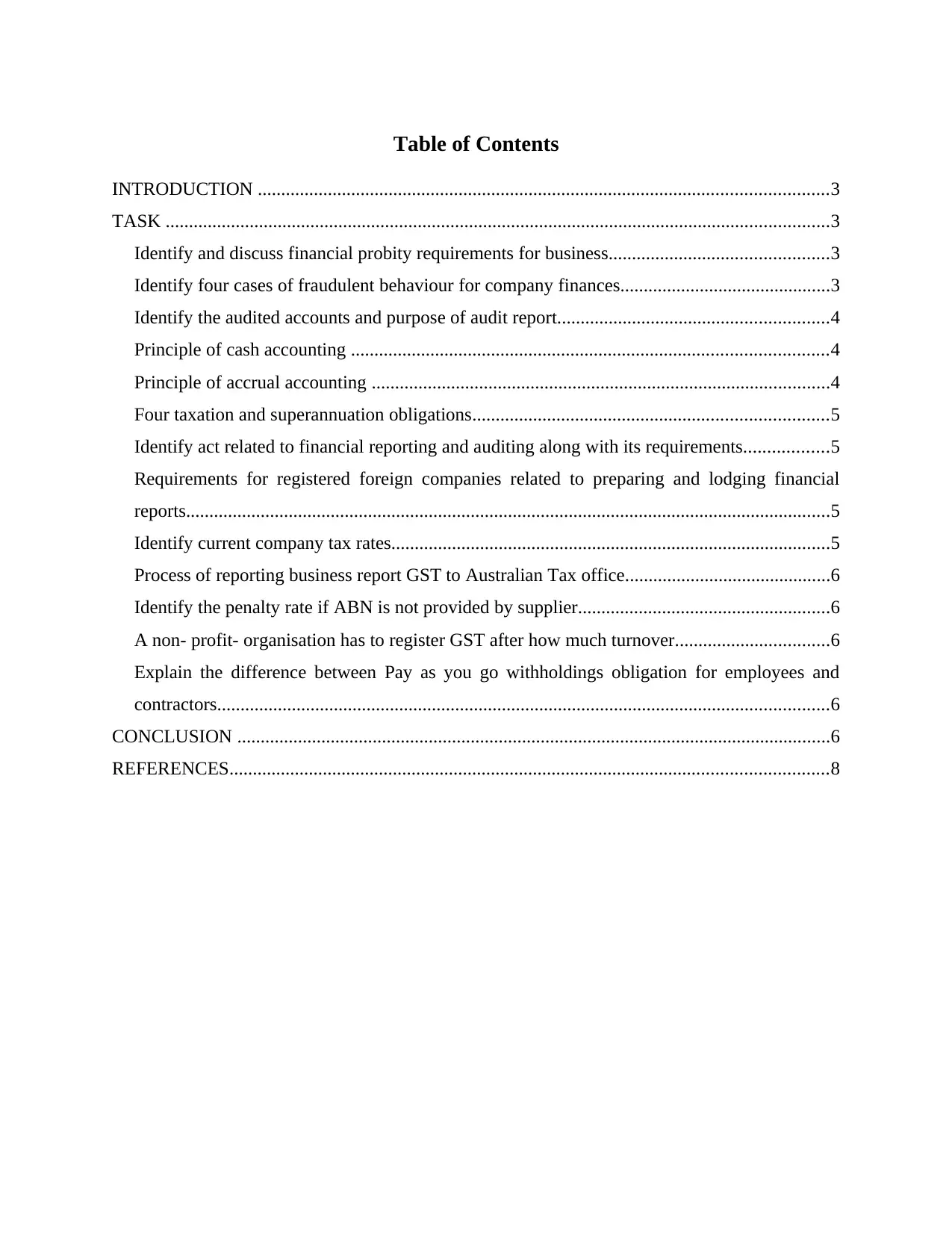
Table of Contents
INTRODUCTION ..........................................................................................................................3
TASK ..............................................................................................................................................3
Identify and discuss financial probity requirements for business...............................................3
Identify four cases of fraudulent behaviour for company finances.............................................3
Identify the audited accounts and purpose of audit report..........................................................4
Principle of cash accounting ......................................................................................................4
Principle of accrual accounting ..................................................................................................4
Four taxation and superannuation obligations............................................................................5
Identify act related to financial reporting and auditing along with its requirements..................5
Requirements for registered foreign companies related to preparing and lodging financial
reports..........................................................................................................................................5
Identify current company tax rates..............................................................................................5
Process of reporting business report GST to Australian Tax office............................................6
Identify the penalty rate if ABN is not provided by supplier......................................................6
A non- profit- organisation has to register GST after how much turnover.................................6
Explain the difference between Pay as you go withholdings obligation for employees and
contractors...................................................................................................................................6
CONCLUSION ...............................................................................................................................6
REFERENCES................................................................................................................................8
INTRODUCTION ..........................................................................................................................3
TASK ..............................................................................................................................................3
Identify and discuss financial probity requirements for business...............................................3
Identify four cases of fraudulent behaviour for company finances.............................................3
Identify the audited accounts and purpose of audit report..........................................................4
Principle of cash accounting ......................................................................................................4
Principle of accrual accounting ..................................................................................................4
Four taxation and superannuation obligations............................................................................5
Identify act related to financial reporting and auditing along with its requirements..................5
Requirements for registered foreign companies related to preparing and lodging financial
reports..........................................................................................................................................5
Identify current company tax rates..............................................................................................5
Process of reporting business report GST to Australian Tax office............................................6
Identify the penalty rate if ABN is not provided by supplier......................................................6
A non- profit- organisation has to register GST after how much turnover.................................6
Explain the difference between Pay as you go withholdings obligation for employees and
contractors...................................................................................................................................6
CONCLUSION ...............................................................................................................................6
REFERENCES................................................................................................................................8
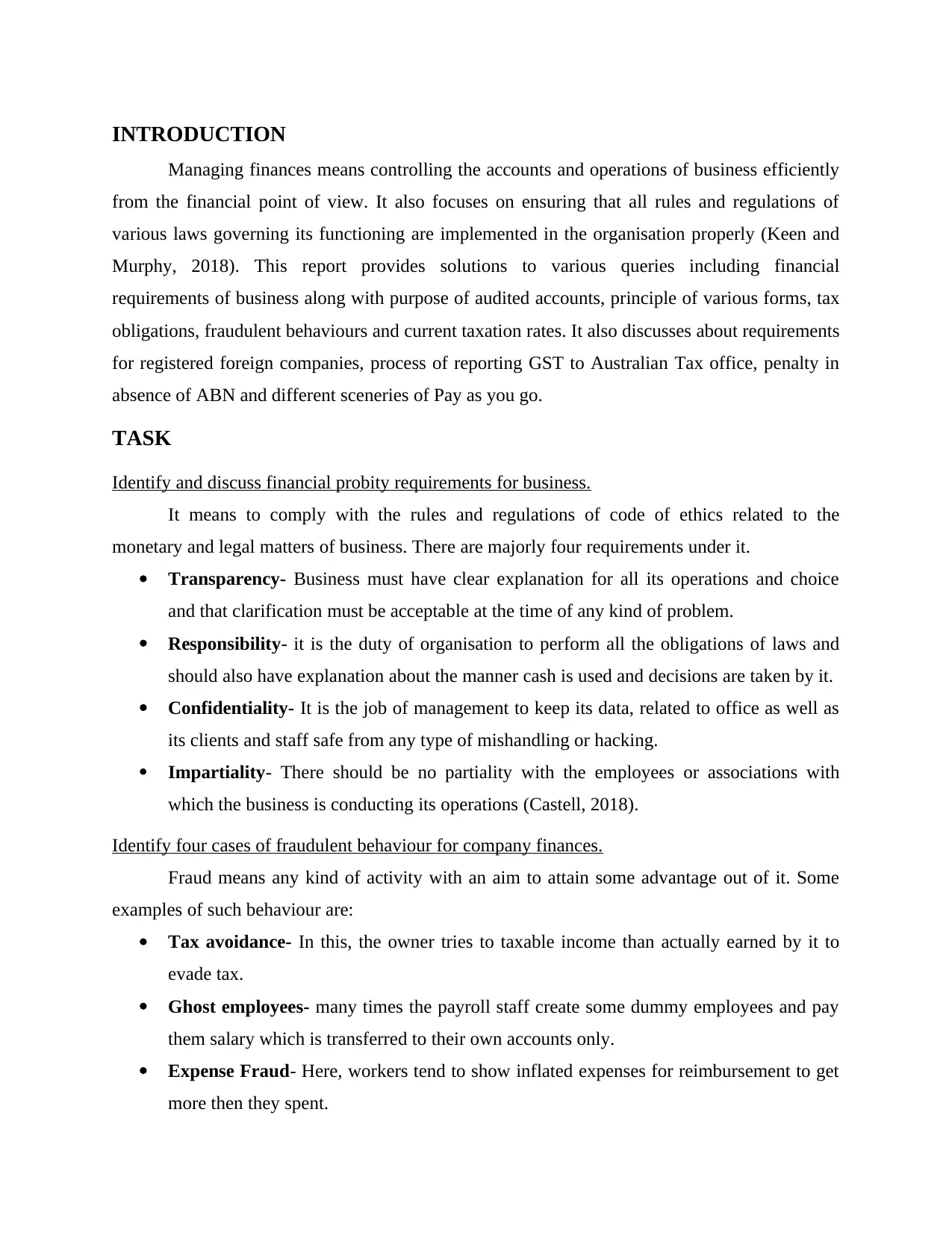
INTRODUCTION
Managing finances means controlling the accounts and operations of business efficiently
from the financial point of view. It also focuses on ensuring that all rules and regulations of
various laws governing its functioning are implemented in the organisation properly (Keen and
Murphy, 2018). This report provides solutions to various queries including financial
requirements of business along with purpose of audited accounts, principle of various forms, tax
obligations, fraudulent behaviours and current taxation rates. It also discusses about requirements
for registered foreign companies, process of reporting GST to Australian Tax office, penalty in
absence of ABN and different sceneries of Pay as you go.
TASK
Identify and discuss financial probity requirements for business.
It means to comply with the rules and regulations of code of ethics related to the
monetary and legal matters of business. There are majorly four requirements under it.
Transparency- Business must have clear explanation for all its operations and choice
and that clarification must be acceptable at the time of any kind of problem.
Responsibility- it is the duty of organisation to perform all the obligations of laws and
should also have explanation about the manner cash is used and decisions are taken by it.
Confidentiality- It is the job of management to keep its data, related to office as well as
its clients and staff safe from any type of mishandling or hacking.
Impartiality- There should be no partiality with the employees or associations with
which the business is conducting its operations (Castell, 2018).
Identify four cases of fraudulent behaviour for company finances.
Fraud means any kind of activity with an aim to attain some advantage out of it. Some
examples of such behaviour are:
Tax avoidance- In this, the owner tries to taxable income than actually earned by it to
evade tax.
Ghost employees- many times the payroll staff create some dummy employees and pay
them salary which is transferred to their own accounts only.
Expense Fraud- Here, workers tend to show inflated expenses for reimbursement to get
more then they spent.
Managing finances means controlling the accounts and operations of business efficiently
from the financial point of view. It also focuses on ensuring that all rules and regulations of
various laws governing its functioning are implemented in the organisation properly (Keen and
Murphy, 2018). This report provides solutions to various queries including financial
requirements of business along with purpose of audited accounts, principle of various forms, tax
obligations, fraudulent behaviours and current taxation rates. It also discusses about requirements
for registered foreign companies, process of reporting GST to Australian Tax office, penalty in
absence of ABN and different sceneries of Pay as you go.
TASK
Identify and discuss financial probity requirements for business.
It means to comply with the rules and regulations of code of ethics related to the
monetary and legal matters of business. There are majorly four requirements under it.
Transparency- Business must have clear explanation for all its operations and choice
and that clarification must be acceptable at the time of any kind of problem.
Responsibility- it is the duty of organisation to perform all the obligations of laws and
should also have explanation about the manner cash is used and decisions are taken by it.
Confidentiality- It is the job of management to keep its data, related to office as well as
its clients and staff safe from any type of mishandling or hacking.
Impartiality- There should be no partiality with the employees or associations with
which the business is conducting its operations (Castell, 2018).
Identify four cases of fraudulent behaviour for company finances.
Fraud means any kind of activity with an aim to attain some advantage out of it. Some
examples of such behaviour are:
Tax avoidance- In this, the owner tries to taxable income than actually earned by it to
evade tax.
Ghost employees- many times the payroll staff create some dummy employees and pay
them salary which is transferred to their own accounts only.
Expense Fraud- Here, workers tend to show inflated expenses for reimbursement to get
more then they spent.
⊘ This is a preview!⊘
Do you want full access?
Subscribe today to unlock all pages.

Trusted by 1+ million students worldwide
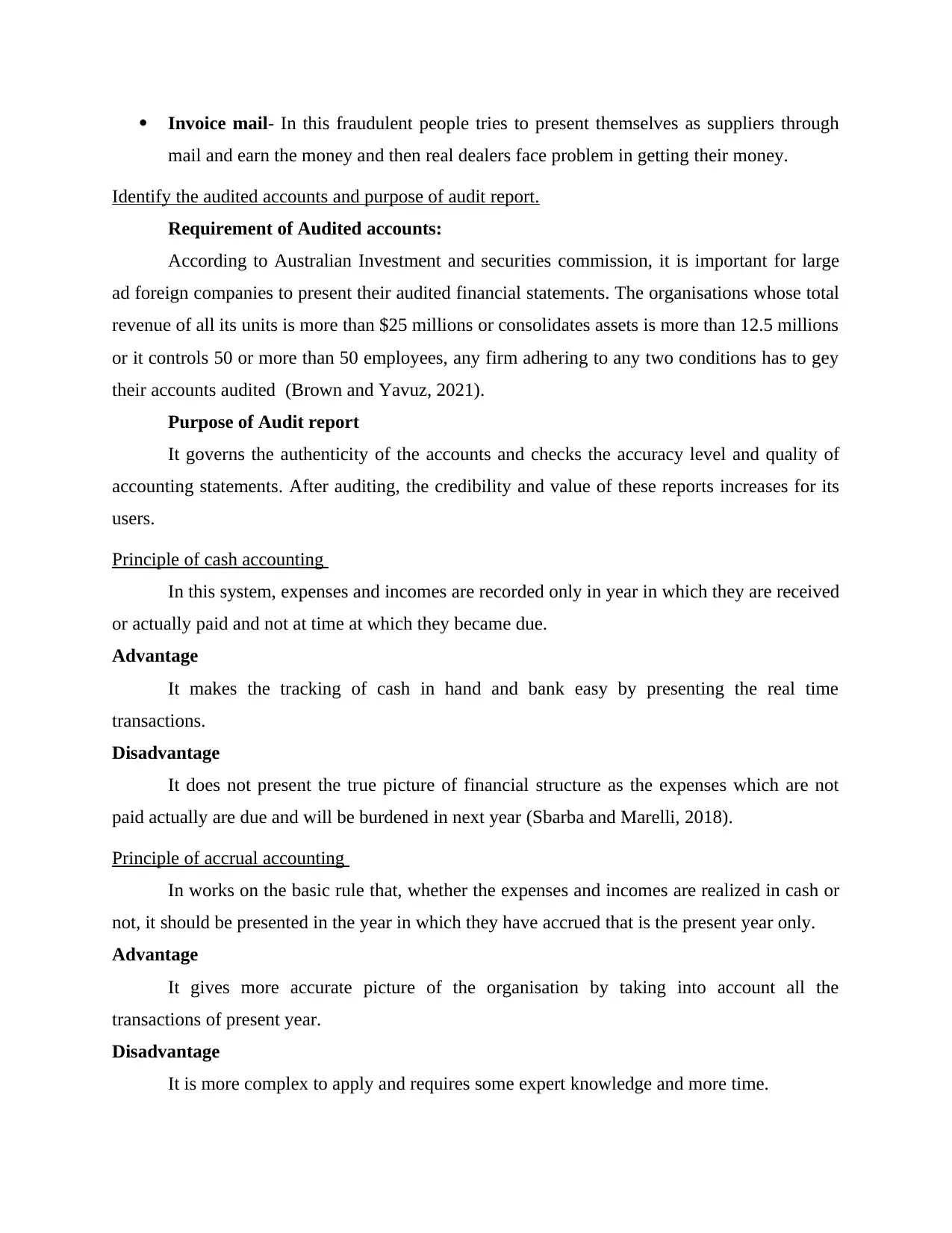
Invoice mail- In this fraudulent people tries to present themselves as suppliers through
mail and earn the money and then real dealers face problem in getting their money.
Identify the audited accounts and purpose of audit report.
Requirement of Audited accounts:
According to Australian Investment and securities commission, it is important for large
ad foreign companies to present their audited financial statements. The organisations whose total
revenue of all its units is more than $25 millions or consolidates assets is more than 12.5 millions
or it controls 50 or more than 50 employees, any firm adhering to any two conditions has to gey
their accounts audited (Brown and Yavuz, 2021).
Purpose of Audit report
It governs the authenticity of the accounts and checks the accuracy level and quality of
accounting statements. After auditing, the credibility and value of these reports increases for its
users.
Principle of cash accounting
In this system, expenses and incomes are recorded only in year in which they are received
or actually paid and not at time at which they became due.
Advantage
It makes the tracking of cash in hand and bank easy by presenting the real time
transactions.
Disadvantage
It does not present the true picture of financial structure as the expenses which are not
paid actually are due and will be burdened in next year (Sbarba and Marelli, 2018).
Principle of accrual accounting
In works on the basic rule that, whether the expenses and incomes are realized in cash or
not, it should be presented in the year in which they have accrued that is the present year only.
Advantage
It gives more accurate picture of the organisation by taking into account all the
transactions of present year.
Disadvantage
It is more complex to apply and requires some expert knowledge and more time.
mail and earn the money and then real dealers face problem in getting their money.
Identify the audited accounts and purpose of audit report.
Requirement of Audited accounts:
According to Australian Investment and securities commission, it is important for large
ad foreign companies to present their audited financial statements. The organisations whose total
revenue of all its units is more than $25 millions or consolidates assets is more than 12.5 millions
or it controls 50 or more than 50 employees, any firm adhering to any two conditions has to gey
their accounts audited (Brown and Yavuz, 2021).
Purpose of Audit report
It governs the authenticity of the accounts and checks the accuracy level and quality of
accounting statements. After auditing, the credibility and value of these reports increases for its
users.
Principle of cash accounting
In this system, expenses and incomes are recorded only in year in which they are received
or actually paid and not at time at which they became due.
Advantage
It makes the tracking of cash in hand and bank easy by presenting the real time
transactions.
Disadvantage
It does not present the true picture of financial structure as the expenses which are not
paid actually are due and will be burdened in next year (Sbarba and Marelli, 2018).
Principle of accrual accounting
In works on the basic rule that, whether the expenses and incomes are realized in cash or
not, it should be presented in the year in which they have accrued that is the present year only.
Advantage
It gives more accurate picture of the organisation by taking into account all the
transactions of present year.
Disadvantage
It is more complex to apply and requires some expert knowledge and more time.
Paraphrase This Document
Need a fresh take? Get an instant paraphrase of this document with our AI Paraphraser
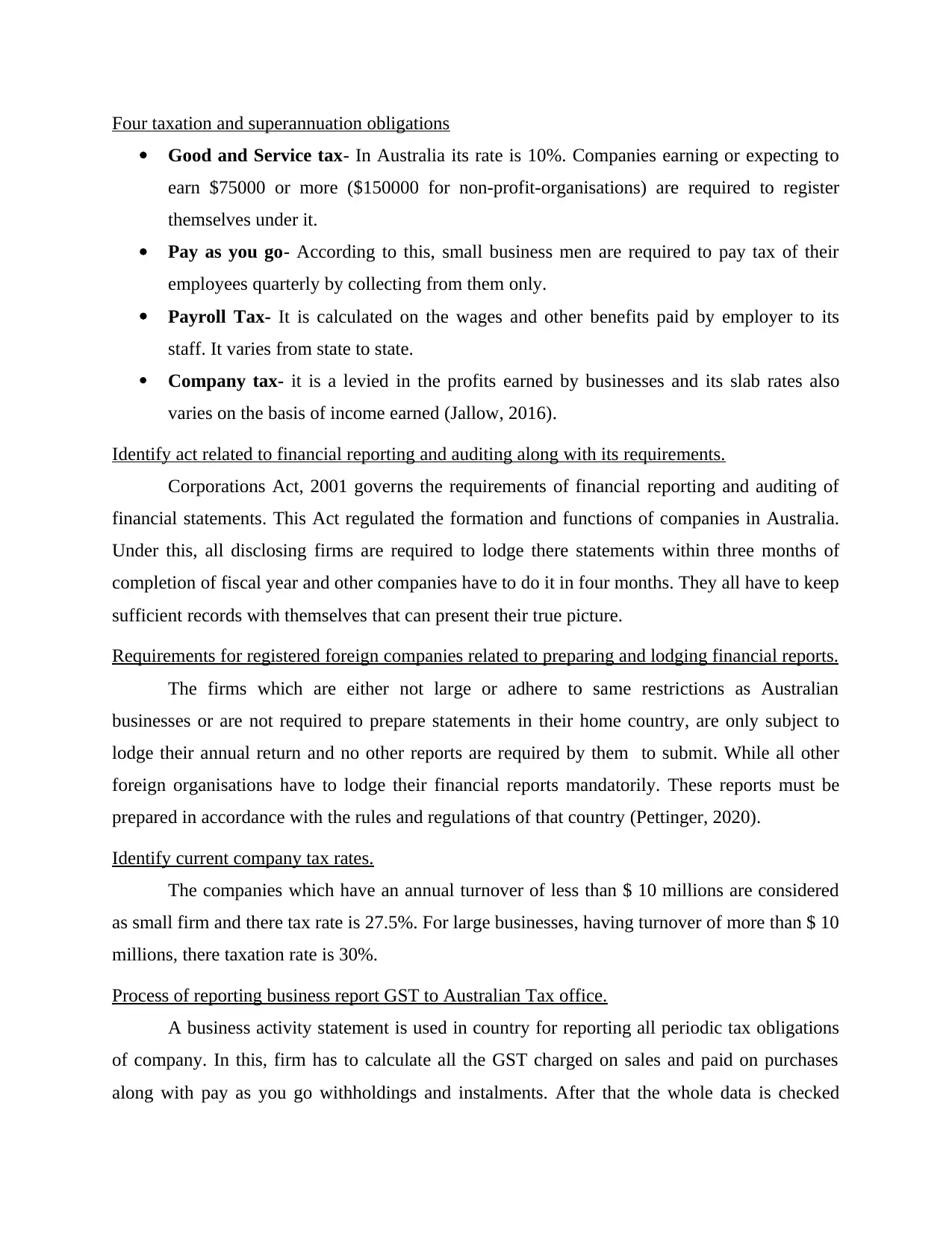
Four taxation and superannuation obligations
Good and Service tax- In Australia its rate is 10%. Companies earning or expecting to
earn $75000 or more ($150000 for non-profit-organisations) are required to register
themselves under it.
Pay as you go- According to this, small business men are required to pay tax of their
employees quarterly by collecting from them only.
Payroll Tax- It is calculated on the wages and other benefits paid by employer to its
staff. It varies from state to state.
Company tax- it is a levied in the profits earned by businesses and its slab rates also
varies on the basis of income earned (Jallow, 2016).
Identify act related to financial reporting and auditing along with its requirements.
Corporations Act, 2001 governs the requirements of financial reporting and auditing of
financial statements. This Act regulated the formation and functions of companies in Australia.
Under this, all disclosing firms are required to lodge there statements within three months of
completion of fiscal year and other companies have to do it in four months. They all have to keep
sufficient records with themselves that can present their true picture.
Requirements for registered foreign companies related to preparing and lodging financial reports.
The firms which are either not large or adhere to same restrictions as Australian
businesses or are not required to prepare statements in their home country, are only subject to
lodge their annual return and no other reports are required by them to submit. While all other
foreign organisations have to lodge their financial reports mandatorily. These reports must be
prepared in accordance with the rules and regulations of that country (Pettinger, 2020).
Identify current company tax rates.
The companies which have an annual turnover of less than $ 10 millions are considered
as small firm and there tax rate is 27.5%. For large businesses, having turnover of more than $ 10
millions, there taxation rate is 30%.
Process of reporting business report GST to Australian Tax office.
A business activity statement is used in country for reporting all periodic tax obligations
of company. In this, firm has to calculate all the GST charged on sales and paid on purchases
along with pay as you go withholdings and instalments. After that the whole data is checked
Good and Service tax- In Australia its rate is 10%. Companies earning or expecting to
earn $75000 or more ($150000 for non-profit-organisations) are required to register
themselves under it.
Pay as you go- According to this, small business men are required to pay tax of their
employees quarterly by collecting from them only.
Payroll Tax- It is calculated on the wages and other benefits paid by employer to its
staff. It varies from state to state.
Company tax- it is a levied in the profits earned by businesses and its slab rates also
varies on the basis of income earned (Jallow, 2016).
Identify act related to financial reporting and auditing along with its requirements.
Corporations Act, 2001 governs the requirements of financial reporting and auditing of
financial statements. This Act regulated the formation and functions of companies in Australia.
Under this, all disclosing firms are required to lodge there statements within three months of
completion of fiscal year and other companies have to do it in four months. They all have to keep
sufficient records with themselves that can present their true picture.
Requirements for registered foreign companies related to preparing and lodging financial reports.
The firms which are either not large or adhere to same restrictions as Australian
businesses or are not required to prepare statements in their home country, are only subject to
lodge their annual return and no other reports are required by them to submit. While all other
foreign organisations have to lodge their financial reports mandatorily. These reports must be
prepared in accordance with the rules and regulations of that country (Pettinger, 2020).
Identify current company tax rates.
The companies which have an annual turnover of less than $ 10 millions are considered
as small firm and there tax rate is 27.5%. For large businesses, having turnover of more than $ 10
millions, there taxation rate is 30%.
Process of reporting business report GST to Australian Tax office.
A business activity statement is used in country for reporting all periodic tax obligations
of company. In this, firm has to calculate all the GST charged on sales and paid on purchases
along with pay as you go withholdings and instalments. After that the whole data is checked
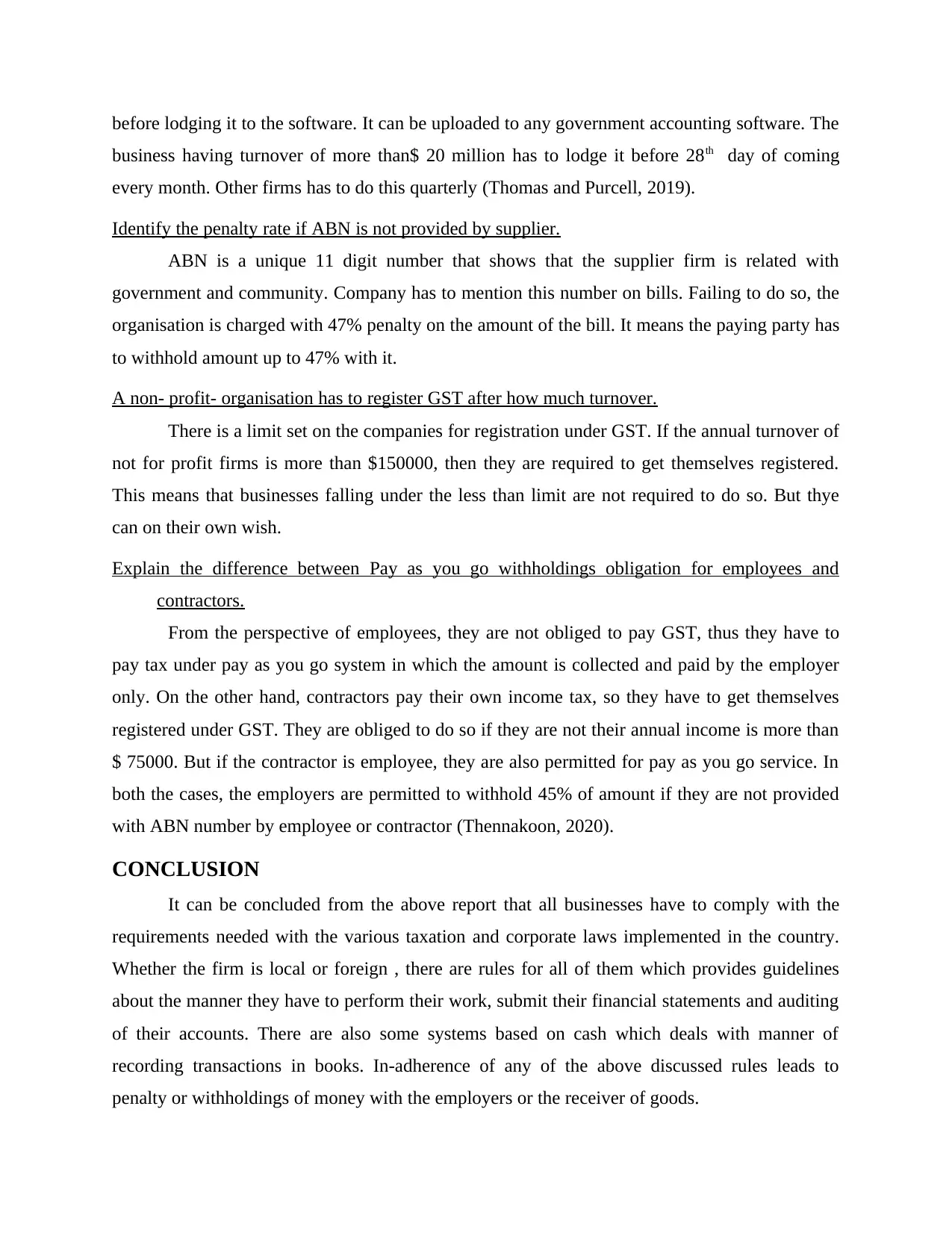
before lodging it to the software. It can be uploaded to any government accounting software. The
business having turnover of more than$ 20 million has to lodge it before 28th day of coming
every month. Other firms has to do this quarterly (Thomas and Purcell, 2019).
Identify the penalty rate if ABN is not provided by supplier.
ABN is a unique 11 digit number that shows that the supplier firm is related with
government and community. Company has to mention this number on bills. Failing to do so, the
organisation is charged with 47% penalty on the amount of the bill. It means the paying party has
to withhold amount up to 47% with it.
A non- profit- organisation has to register GST after how much turnover.
There is a limit set on the companies for registration under GST. If the annual turnover of
not for profit firms is more than $150000, then they are required to get themselves registered.
This means that businesses falling under the less than limit are not required to do so. But thye
can on their own wish.
Explain the difference between Pay as you go withholdings obligation for employees and
contractors.
From the perspective of employees, they are not obliged to pay GST, thus they have to
pay tax under pay as you go system in which the amount is collected and paid by the employer
only. On the other hand, contractors pay their own income tax, so they have to get themselves
registered under GST. They are obliged to do so if they are not their annual income is more than
$ 75000. But if the contractor is employee, they are also permitted for pay as you go service. In
both the cases, the employers are permitted to withhold 45% of amount if they are not provided
with ABN number by employee or contractor (Thennakoon, 2020).
CONCLUSION
It can be concluded from the above report that all businesses have to comply with the
requirements needed with the various taxation and corporate laws implemented in the country.
Whether the firm is local or foreign , there are rules for all of them which provides guidelines
about the manner they have to perform their work, submit their financial statements and auditing
of their accounts. There are also some systems based on cash which deals with manner of
recording transactions in books. In-adherence of any of the above discussed rules leads to
penalty or withholdings of money with the employers or the receiver of goods.
business having turnover of more than$ 20 million has to lodge it before 28th day of coming
every month. Other firms has to do this quarterly (Thomas and Purcell, 2019).
Identify the penalty rate if ABN is not provided by supplier.
ABN is a unique 11 digit number that shows that the supplier firm is related with
government and community. Company has to mention this number on bills. Failing to do so, the
organisation is charged with 47% penalty on the amount of the bill. It means the paying party has
to withhold amount up to 47% with it.
A non- profit- organisation has to register GST after how much turnover.
There is a limit set on the companies for registration under GST. If the annual turnover of
not for profit firms is more than $150000, then they are required to get themselves registered.
This means that businesses falling under the less than limit are not required to do so. But thye
can on their own wish.
Explain the difference between Pay as you go withholdings obligation for employees and
contractors.
From the perspective of employees, they are not obliged to pay GST, thus they have to
pay tax under pay as you go system in which the amount is collected and paid by the employer
only. On the other hand, contractors pay their own income tax, so they have to get themselves
registered under GST. They are obliged to do so if they are not their annual income is more than
$ 75000. But if the contractor is employee, they are also permitted for pay as you go service. In
both the cases, the employers are permitted to withhold 45% of amount if they are not provided
with ABN number by employee or contractor (Thennakoon, 2020).
CONCLUSION
It can be concluded from the above report that all businesses have to comply with the
requirements needed with the various taxation and corporate laws implemented in the country.
Whether the firm is local or foreign , there are rules for all of them which provides guidelines
about the manner they have to perform their work, submit their financial statements and auditing
of their accounts. There are also some systems based on cash which deals with manner of
recording transactions in books. In-adherence of any of the above discussed rules leads to
penalty or withholdings of money with the employers or the receiver of goods.
⊘ This is a preview!⊘
Do you want full access?
Subscribe today to unlock all pages.

Trusted by 1+ million students worldwide

Paraphrase This Document
Need a fresh take? Get an instant paraphrase of this document with our AI Paraphraser
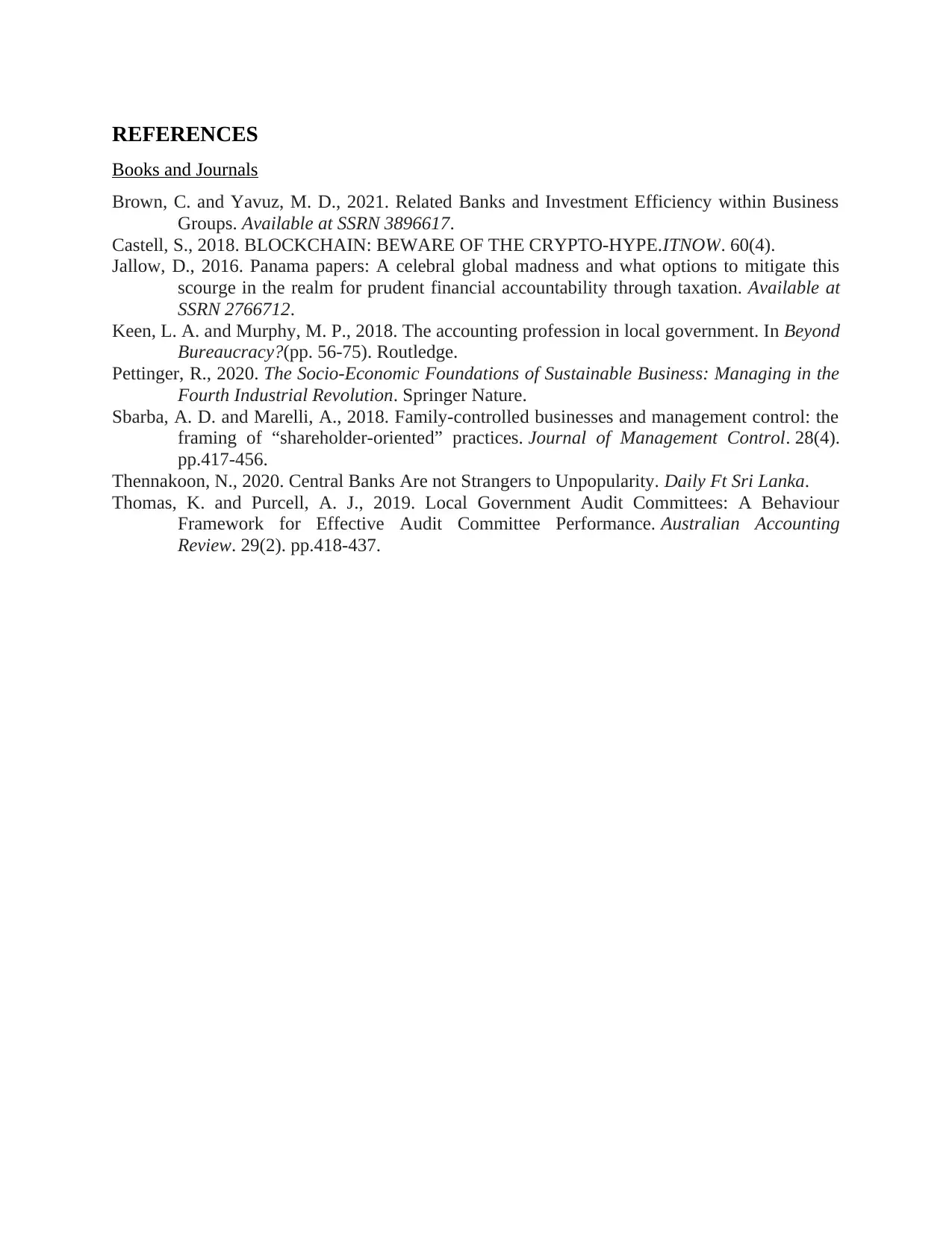
REFERENCES
Books and Journals
Brown, C. and Yavuz, M. D., 2021. Related Banks and Investment Efficiency within Business
Groups. Available at SSRN 3896617.
Castell, S., 2018. BLOCKCHAIN: BEWARE OF THE CRYPTO-HYPE.ITNOW. 60(4).
Jallow, D., 2016. Panama papers: A celebral global madness and what options to mitigate this
scourge in the realm for prudent financial accountability through taxation. Available at
SSRN 2766712.
Keen, L. A. and Murphy, M. P., 2018. The accounting profession in local government. In Beyond
Bureaucracy?(pp. 56-75). Routledge.
Pettinger, R., 2020. The Socio-Economic Foundations of Sustainable Business: Managing in the
Fourth Industrial Revolution. Springer Nature.
Sbarba, A. D. and Marelli, A., 2018. Family-controlled businesses and management control: the
framing of “shareholder-oriented” practices. Journal of Management Control. 28(4).
pp.417-456.
Thennakoon, N., 2020. Central Banks Are not Strangers to Unpopularity. Daily Ft Sri Lanka.
Thomas, K. and Purcell, A. J., 2019. Local Government Audit Committees: A Behaviour
Framework for Effective Audit Committee Performance. Australian Accounting
Review. 29(2). pp.418-437.
Books and Journals
Brown, C. and Yavuz, M. D., 2021. Related Banks and Investment Efficiency within Business
Groups. Available at SSRN 3896617.
Castell, S., 2018. BLOCKCHAIN: BEWARE OF THE CRYPTO-HYPE.ITNOW. 60(4).
Jallow, D., 2016. Panama papers: A celebral global madness and what options to mitigate this
scourge in the realm for prudent financial accountability through taxation. Available at
SSRN 2766712.
Keen, L. A. and Murphy, M. P., 2018. The accounting profession in local government. In Beyond
Bureaucracy?(pp. 56-75). Routledge.
Pettinger, R., 2020. The Socio-Economic Foundations of Sustainable Business: Managing in the
Fourth Industrial Revolution. Springer Nature.
Sbarba, A. D. and Marelli, A., 2018. Family-controlled businesses and management control: the
framing of “shareholder-oriented” practices. Journal of Management Control. 28(4).
pp.417-456.
Thennakoon, N., 2020. Central Banks Are not Strangers to Unpopularity. Daily Ft Sri Lanka.
Thomas, K. and Purcell, A. J., 2019. Local Government Audit Committees: A Behaviour
Framework for Effective Audit Committee Performance. Australian Accounting
Review. 29(2). pp.418-437.
1 out of 8
Related Documents
Your All-in-One AI-Powered Toolkit for Academic Success.
+13062052269
info@desklib.com
Available 24*7 on WhatsApp / Email
![[object Object]](/_next/static/media/star-bottom.7253800d.svg)
Unlock your academic potential
Copyright © 2020–2025 A2Z Services. All Rights Reserved. Developed and managed by ZUCOL.




